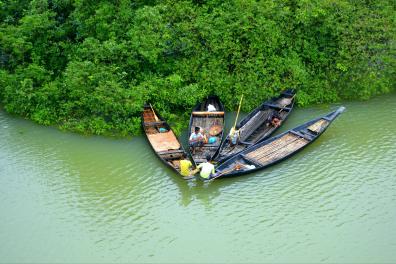This page has been translated automatically.
Bengali
Discovering the language
One of the most eastern of the Indo-European languages, Bengali is part of the Indo-Aryan group dominant in northern India. It has borrowed heavily from the prestigious Sanskrit language, but has also absorbed considerable Arabic-Persian lexical input. The syllabic script is similar to the Devanagari script used in Hindi. On both sides of the Indo-Bangladeshi border, there is a Bengali language common to the media and academic expression. But, especially in Bangladesh, regional dialects retain a very marked and lively originality.
Bengali is rich in equally developed literature in its scholarly and popular forms, both ancient and modern. Medieval literature, essentially religious in inspiration and almost exclusively in verse, developed from the 17th to the 18th century. Its study shows that Bengali is the common heritage of the Muslims and Hindus of Bengal, and as such is of interest for the study of non-Arab Islam as well as Hinduism. The 19th century saw the emergence of a radically renewed literature, in which prose found its letters of nobility. Calcutta, capital of British India until 1911, became the center of intellectual encounters with the West. Modern literature began in earnest with Tagore, winner of the Nobel Prize for Literature in 1913, who practiced all literary and artistic genres with genius. Since 1947, and even more so since the independence of Bangladesh in 1971, a literature has emerged in this eastern part of Bengal that is gradually acquiring a distinct personality. Cinema occupies an important place in Bengal's artistic creation, appreciated in France by the screening of works by Satyajit Ray and Ritwik Ghatak. Baul singers are another aspect of Bengali culture that has been attracting Western audiences in recent years.
Example courses
- Applied grammar of Bengali
- Phonology of Bengali
- Politics and institutions of contemporary India
- Bengali cinema
- Literary translation and contemporary Bengali literature
Professional opportunities
- Diplomacy: Bengali can be entered as a second or optional language in certain competitive examinations held by the Ministry of Foreign Affairs.
- Legal and social translation and interpreting: the number of Bengali speakers (generally with little knowledge of French) has been growing steadily for several years, made up of immigrants and statutory refugees; the often precarious situation of these immigrants requires translations of official civil status and other documents, asylum application documents, medical, school and legal documents that require qualified translators, of whom there have been very few in France up to now.
- Literary translation: Bengali literature enjoys great prestige and is extremely rich.
- Research in Bengali language and literature, anthropology and ethnology, and in history and political science (this field has proved particularly promising in recent years, with the growing development and interest in studies of the contemporary Islamic world and the relations between Islam and politics, with a geostrategic scope of the first order).
- Education
- Psychiatry and psychology: with the number of Bengali speakers steadily increasing for several years, made up of immigrants and statutory refugees, often in fragile situations, the needs in this field are pressing.
- Humanitarian work: Bangladesh's humanitarian needs are colossal; field work with NGOs and other humanitarian organizations requires knowledge of the local language
- Tourism: tourism is a developing sector in India and Bangladesh.
- Economy: trade and industrial exchanges between France and Bangladesh have been developing for some twenty years.
